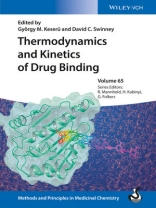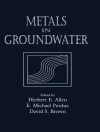This practical reference for medicinal and pharmaceutical chemists combines the theoretical background with modern methods as well as applications from recent lead finding and optimization projects.
Divided into two parts on the thermodynamics and kinetics of drug-receptor interaction, the text provides the conceptual and methodological basis for characterizing binding mechanisms for drugs and other bioactive molecules. It covers all currently used methods, from experimental approaches, such as ITC or SPR, right up to the latest computational methods. Case studies of real-life lead or drug development projects are also included so readers can apply the methods learned to their own projects. Finally, the benefits of a thorough binding mode analysis for any drug development project are summarized in an outlook chapter written by the editors.
Tabela de Conteúdo
List of Contributors XIII
Preface XIX
A Personal Foreword XXI
Section I: Thermodynamics 1
1 The Binding Thermodynamics of Drug Candidates 3
Ernesto Freire
1.1 Affinity Optimization 3
1.2 The Binding Affinity 4
1.3 The Enthalpy Change 6
1.4 The Entropy Change 7
1.5 Engineering Binding Contributions 9
1.6 Lipophilic Efficiency and Binding Enthalpy 11
Acknowledgments 12
References 12
2 van’t Hoff Based Thermodynamics 15
Katia Varani, Stefania Gessi, Stefania Merighi, and Pier Andrea Borea
2.1 Relevance of Thermodynamics to Pharmacology 15
2.2 Affinity Constant Determination 16
2.3 The Origin of van’t Hoff Equation 17
2.4 From van’t Hoff toward Thermodynamic Discrimination 18
2.5 Representation of ΔG∘, ΔH∘, and ΔS∘ Data 20
2.6 The Adenosine Receptors Binding Thermodynamics Story 21
2.7 Binding Thermodynamics of G-Protein Coupled Receptors 25
2.8 Binding Thermodynamics of Ligand-Gated Ion Channel Receptors 26
2.9 Discussion 29
Abbreviations 31
References 32
3 Computation of Drug-Binding Thermodynamics 37
György G. Ferenczy
3.1 Introduction 37
3.2 Potential of Mean Force Calculations 39
3.3 Alchemical Transformations 41
3.4 Nonequilibrium Methods 44
3.5 MM-PBSA 44
3.6 Linear Interaction Energy 47
3.7 Scoring Functions 48
3.8 Free-energy Components 50
3.9 Summary 52
References 52
4 Thermodynamics-Guided Optimizations in Medicinal Chemistry 63
György M. Keserü
4.1 Introduction 63
4.2 The Thermodynamics of Medicinal Chemistry Optimizations 66
4.3 Selection of Suitable Starting Points 70
4.4 Thermodynamics Based Optimization Strategies 73
References 78
5 From Molecular Understanding to Structure–Thermodynamic Relationships, the Case of Acetylcholine Binding Proteins 81
Antoni R. Blaazer and Iwan J. P. de Esch
5.1 Introduction 81
5.1.1 Natural n ACh R Ligands 82
5.1.2 n ACh R Ligands as Therapeutic Agents 83
5.2 Acetylcholine Binding Proteins (ACh BPs) 85
5.3 Thermodynamics of Small Molecule Binding at ACh BPs 89
5.4 Concluding Remarks and Outlook 98
References 99
6 Thermodynamics in Lead Optimization 107
Geoffrey A. Holdgate, Andrew Scott, and Gareth Davies
6.1 Introduction to Lead Optimization in Drug Discovery 107
6.2 Measurement of Thermodynamic Parameters in Lead Optimization 111
6.3 Advantages during Lead Optimization for Thermodynamic Measurements 117
6.4 Exploitation of Measured Thermodynamics in Lead Optimization 118
6.5 Lead Optimization beyond Affinity 120
6.6 Exemplary Case Studies 123
6.7 Potential Complicating Factors in Exploiting Thermodynamics in Lead Optimization 126
6.8 Summary 132
References 133
7 Thermodynamic Profiling of Carbonic Anhydrase Inhibitors 137
Lyn H. Jones
7.1 Introduction 137
7.2 Thermodynamic Profiles of Fragment Inhibitors 139
7.3 Thermodynamics of Fragment Growing 146
7.4 Conclusions 147
Acknowledgments 148
References 149
Section II: Kinetics 155
8 Drug–Target Residence Time 157
Robert A. Copeland
8.1 Introduction 157
8.2 Open and Closed Systems in Biology 157
8.3 Mechanisms of Drug–Target Interactions 159
8.4 Impact of Residence Time on Cellular Activity 161
8.5 Impact on Efficacy and Duration In vivo 163
8.6 Limitations of Drug–Target Residence Time 166
8.7 Summary 167
References 167
9 Experimental Methods to Determine Binding Kinetics 169
Georges Vauquelin, Walter Huber, and David C. Swinney
9.1 Introduction 169
9.2 Definitions 170
9.3 Experimental Strategy 171
9.4 Experimental Methodologies 172
9.5 Specific Issues 183
9.6 Conclusion 185
Acknowledgment 185
References 185
10 Challenges in the Medicinal Chemical Optimization of Binding Kinetics 191
Michael J.Waring, Andrew G. Leach, and Duncan C.Miller
10.1 Introduction 191
10.2 Challenges 192
10.3 Optimization in Practice 199
10.4 Summary and Conclusions 208
References 209
11 Computational Approaches for Studying Drug Binding Kinetics 211
Julia Romanowska, Daria B. Kokh, Jonathan C. Fuller, and Rebecca C.Wade
11.1 Introduction 211
11.2 Theoretical Background 211
11.3 Model Types and Force Fields 218
11.4 Application Examples 222
11.5 Summary and Future Directions 228
Acknowledgments 228
References 229
12 The Use of Structural Information to Understand Binding Kinetics 237
Felix Schiele, Pelin Ayaz, and Anke Müller-Fahrnow
12.1 Introduction 237
12.2 Binding Kinetics 238
12.3 Methods to Obtain Structural Information to Understand Binding Kinetics 241
12.4 Literature on Structure Kinetic Relationships 242
12.5 Current Thinking on the Structural Factors That Influence Binding Kinetics 251
12.6 Concluding Remarks 252
References 253
13 Importance of Drug–Target Residence Time at G Protein-Coupled Receptors – a Case for the Adenosine Receptors 257
Dong Guo, Adriaan P. IJzerman, and Laura H. Heitman
13.1 Introduction 257
13.2 The Adenosine Receptors 257
13.3 Mathematical Definitions of Drug–Target Residence Time 258
13.4 Current Kinetic Radioligand Assays 260
13.5 Dual-Point Competition Association Assay: a Fast and High-Throughput Kinetic Screening Method 261
13.6 Drug–Target Residence Time: an Often Overlooked Key Aspect for a Drug’s Mechanism of Action 267
13.7 Conclusions 270
Acknowledgments 271
References 271
14 Case Study: Angiotensin Receptor Blockers (ARBs) 273
Georges Vauquelin
14.1 Introduction 273
14.2 Insurmountable Antagonism 275
14.3 From Partial Insurmountability to an Induced Fit-Binding Mechanism 280
14.4 Sartan Rebinding Contributes to Long-Lasting AT1-Receptor Blockade 283
14.5 Summary and Final Considerations 287
References 288
15 The Kinetics and Thermodynamics of Staphylococcus aureus Fab I Inhibition 295
Andrew Chang, Kanishk Kapilashrami, Eleanor K. H. Allen, and Peter J. Tonge
15.1 Introduction 295
15.2 Fatty Acid Biosynthesis as a Novel Antibacterial Target 296
15.3 Inhibition of sa Fab I 297
15.4 Computer-Aided Enzyme Kinetics to Characterize sa Fab I Inhibition 298
15.5 Orthogonal Methods to Measure Drug–Target Residence Time 298
15.6 Mechanism-Dependent Slow-Binding Kinetics 303
15.7 Mechanistic Basis for Binary Complex Selectivity 303
15.8 Rational Design of Long Residence Time Inhibition 304
15.9 Summary 306
References 307
Section III: Perspective 313
16 Thermodynamics and Binding Kinetics in Drug Discovery 315
György M. Keserü and David C. Swinney
16.1 Introduction 315
16.2 Reaction Coordinate 316
16.3 Competing Rates 317
16.4 Thermodynamic Controlled Process – Competing Rates under Equilibrium Conditions 317
16.5 Kinetics Controlled Processes – Competing Rates under Non-equilibrium Conditions 318
16.6 Conformational Controlled Process – Kinetics as a Diagnostic for Conformational Change 319
16.7 The Value of Thermodynamics Measurements to Drug Discovery 320
16.8 Complementarity of Binding Kinetics and Thermodynamic to Discover Safer Medicines 327
References 328
Index 331
Sobre o autor
György Keserü obtained his Ph.D. at the University of Budapest (Hungary) and joined Sanofi-Aventis heading a chemistry research lab. In 1999, he moved to Gedeon Richter as the Head of Computer-aided Drug Discovery, being appointed as the Head of Discovery Chemistry in 2007. Since 2003, he also holds a research professorship at the Budapest University of Technology and Economics. His research interests include medicinal chemistry, drug design, and in silico ADME. He has published over 150 papers and more than 10 books and book chapters. Recently he was granted the Prous award by the European Federation of Medicinal Chemistry, EFMC.
David Swinney obtained his Ph D at the University of Washington in Seattle (USA). He spent 8 years at Syntex Palo Alto before moving on to Roche where he was serving as Department Head of Inflammation and Respiratory Diseases and later as Director of Biochemical Pharmacology. In 2010 he founded the Institute for Rare and Neglected Diseases, which is a non-profit drug discovery organization. Dr. Swinney is an international expert in enzymology and pharmacology with special interest in molecular mechanism of drug action and binding kinetics.












